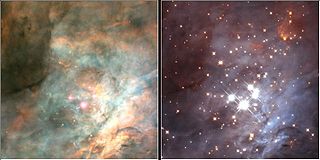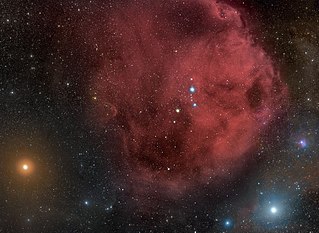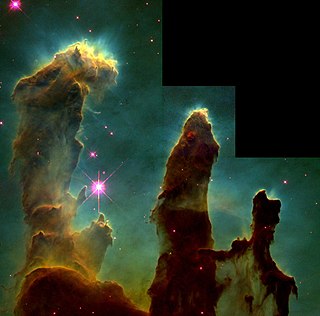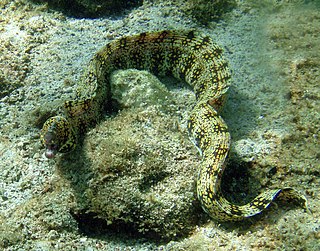This page is based on this
Wikipedia article Text is available under the
CC BY-SA 4.0 license; additional terms may apply.
Images, videos and audio are available under their respective licenses.

A planetary nebula, abbreviated as PN or plural PNe, is a type of emission nebula consisting of an expanding, glowing shell of ionized gas ejected from red giant stars late in their lives.

The Orion Nebula is a diffuse nebula situated in the Milky Way, being south of Orion's Belt in the constellation of Orion. It is one of the brightest nebulae, and is visible to the naked eye in the night sky. M42 is located at a distance of 1,344 ± 20 light years and is the closest region of massive star formation to Earth. The M42 nebula is estimated to be 24 light years across. It has a mass of about 2,000 times that of the Sun. Older texts frequently refer to the Orion Nebula as the Great Nebula in Orion or the Great Orion Nebula.

The Rosette Nebula is a large spherical H II region located near one end of a giant molecular cloud in the Monoceros region of the Milky Way Galaxy. The open cluster NGC 2244 is closely associated with the nebulosity, the stars of the cluster having been formed from the nebula's matter.

The Tarantula Nebula is an H II region in the Large Magellanic Cloud (LMC).

Moray eels, or Muraenidae, are a family of eels whose members are found worldwide. There are approximately 200 species in 15 genera which are almost exclusively marine, but several species are regularly seen in brackish water, and a few are found in fresh water.
A pinwheel nebula is a nebulous region in the shape of a pinwheel.

Sh2-279 is an HII region and bright nebulae that includes a reflection nebula located in the constellation Orion. It is the northernmost part of the asterism known as Orion's Sword, lying 0.6° north of the Orion Nebula. The reflection nebula embedded in
Sh2-279 is popularly known as the Running Man Nebula.

NGC 1514 is a planetary nebula that was discovered by William Herschel on November 13, 1790, describing it "A most singular phaenomenon" and forcing him to rethink his ideas on the construction of the heavens. Up until this point Herschel was convinced that all nebulae consisted of masses of stars too remote to resolve, but now here was a single star "surrounded with a faintly luminous atmosphere." He concluded: "Our judgement I may venture to say, will be, that the nebulosity about the star is not of a starry nature."

The Trapezium or Orion Trapezium Cluster, also known by its Bayer designation of Theta1 Orionis, is a tight open cluster of stars in the heart of the Orion Nebula, in the constellation of Orion. It was discovered by Galileo Galilei. On February 4, 1617 he sketched three of the stars, but missed the surrounding nebulosity. The fourth component (B) was identified by several observers in 1673, and several more components were discovered later, for a total of eight by 1888. Subsequently, several of the stars were determined to be binaries. Telescopes of amateur astronomers from about 5 inch aperture can resolve six stars under good seeing conditions.
Pearly or pearlie may refer to:
A nebula is a cloud of gas and dust in space.

IC 4703 is the diffuse emission nebula or HII region associated with Messier 16, which is actually a cluster of stars. It is the nebulous region surrounding Messier 16. These two objects make up the Eagle Nebula. They are relatively bright and are located in the constellation Serpens Cauda. This region contains the picturesque Pillars of Creation. This is an active star forming region 7,000 light years away. It is approximately magnitude 8. The cluster was discovered by De Cheseaux, but Messier later rediscovered it and remarked on its apparent nebulous appearance. The cluster is estimated to be 5.5 million years old, and the nebula would be a bit older. The nebula is about 55 x 70 light years. The Eagle Nebula lies in the Sagittarius Arm of the Milky Way.

The Sadr region, or IC 1318, is the diffuse emission nebula surrounding Sadr at the center of Cygnus's cross. The Sadr region is one of the surrounding nebulous regions; others include the Butterfly Nebula and the Crescent Nebula. It contains many dark nebulae in addition to the emission diffuse nebulae.

Simeis 147, also known as the Spaghetti Nebula, SNR G180.0-01.7 or Sharpless 2-240, is a supernova remnant (SNR) in the Milky Way, straddling the border between the constellations Auriga and Taurus. Discovered in 1952 at the Crimean Astrophysical Observatory using a 25-inch Schmidt-Cassegrain telescope, it is difficult to observe due to its extremely low brightness.
Sh 2-1, also known as Sharpless 1, is a reflection nebula in the constellation of Scorpius. It appears as a modest brightness making it one of the easier Sharpless catalog objects to view. It features an apparent central star inside the nebulosity however it is not part its system nor a left over remnant.
Sh 2-2, also known as Sharpless 2, is an emission nebula in the constellation of Scorpius. It appears as a mid-range brightness making it difficult to view. It is believed to currently host an X-ray binary star that originated and was ejected from the Scorpius OB1 association.

Sharpless 264, also known as the Lambda Orionis Ring, is a molecular cloud and H II region, which can be seen in the northern region of the Orion Molecular Cloud Complex (OMCC), in the constellation of Orion. The OMCC is one of the best-known star formation regions and the closest sector of the Milky Way to our Solar System where high-mass stars are born. The nebula is named after its main star, λ Orionis, a blue giant responsible for the ionization of the surrounding material. It is also sometimes called the Angelfish Nebula due to its resemblance as to its lighter areas to an angelfish. In the infrared its ionized boundaries are that which appears, instead.















